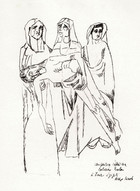Max Jacob
(1876-1944)
Max Jacob knew everyone there was to know in Paris of the 1920s and 1930s. The French poet-artist could count Pablo Picasso, Jean Cocteau, Gertrude Stein, and Coco Chanel among his friends and intimates. A gifted mimic, raconteur, and table-top-dancer, he was dubbed “The Harlequin of Montmarte.” The frantic social-networking and tomfoolery masked Jacob's inner anguish as a homosexual Jew and, later, Roman Catholic convert, ill at ease in his identities. Jacob made his mark on contemporary French culture. He was present at the birth of Modern Art in Picasso’s Bateau-Lavoir studio and revolutionized French verse in alliterative prose poems capturing the cadences of human speech.
Jacob came from a family of secular Jewish merchants, a rarity in the Breton town of Quimper where he was born in 1876. Memories of the pagan folklore of Brittany, its carved stone Crucifixion scenes, and church “pardon” processionals (like one depicted in a 1937 print) were a rich resource for his poetry and the paintings that were his major source of of income, nurturing a mystical spirituality. Ravaged by his bohemian high-life, Jacob first had a vision of Christ on a red wall hanging in his Paris room in 1909. A second image of Jesus appeared before his eyes on a cinema screen. He was baptized into the Catholic Church in 1915 with Picasso as his godfather.
Jacob recounted his conversion with dramatic flair in poetic prose works like Saint Matorel and La Defense de Tartufe. He kept the faith in his own fashion with one foot in the avant-garde art scene and the other in the confessional. In 1921, Jacob left Paris and its temptations behind for Saint-Benoit-sur-Loire, living in genteel poverty for the next seven years at the town’s historic abbey and in nearby rooms. He attended daily Mass, wrote poetry, painted in gouache, and welcomed a steady stream of young artist-acolytes, often mixing attempts at conversion with seduction. Jacob sought refuge at the pilgrimage center again in 1938, when war loomed in Europe.
The poet-artist was especially drawn to an “embodied” Christianity, often re-enacting the Stations of the Cross for visitors to the abbey. During a liaison dangereuse on a Breton isle in 1927 with Maurice Sachs, a debonair con-man and adroit social-climber, Jacob created forty drawings of the Passion of Christ. Sachs convinced Jacob to reproduce them in the album, Visions des souffrances et de la mort de Jesus fils de Dieu, in the vain hope of launching himself as a publisher. The free-style ink sketches with cross-outs and blot-marks bring to mind the drawings of Picasso with a peculiar delicacy and pathos absent in the work of Jacob's idol. We only have eyes for the humiliation and pain of the divine victim.
The calvaire sculpture groupings in the villages of Jacob’s native Brittany were the inspiration for the illustrations in Meditations Religieuses, a posthumously published volume of the artist’s devotional writings from the time of the Nazi Occupation. A colored frontispiece shows the Creator God giving life to Adam. The simply-contoured biblical scenes accompany a text where this sinner who yearned to be a saint swings between hope and despair in lyrical reflections on heaven, hell, and the mercy of God, seeking to come to terms with his intertwined personas. In the first meditation, dated September 1941, Jacob wrote: “I thank you for making me to be born of the suffering Jewish race since only those are saved who suffer and know they suffer and offer their suffering to God.”
Baptized or not, the poet-artist had to wear the identifying yellow star of a Jew. On February 24, 1944, one day after Jacob had been marked with ashes at the beginning of Lent, Gestapo agents arrested him at his boarding house in Saint-Benoit-sur-Loire. He died of pneumonia on March 5 at the infamous Drancy internment camp in Paris. Jacob was on a list for transport to Auschwitz two days later. Cocteau and other close friends from Jacob’s bohemian past tried and failed to get him released. When Picasso was asked to help, he replied: “Max is an angel. He can fly over the wall by himself.”

Procession of the Queen of Vines
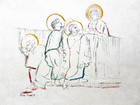
The Last Supper
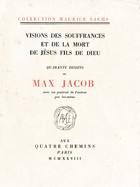
Visions des souffrances (Title page)

Jacob Self-Portrait (dedication page)
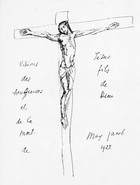
Visions des souffrances (Illustrated title page)
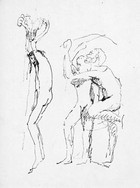
Visions des souffrances (Flagellation of Jesus)

Visions des souffrances (Giving of the Cross)
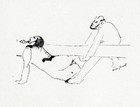
Visions des souffrances (The Help of Simon)
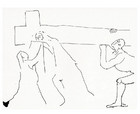
Visions des souffrances (The Love of St. Veronica)
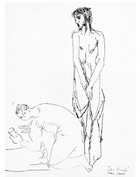
Visions des souffrances (Jesus is Stripped)

Visions des souffrances (The Crucifixion)
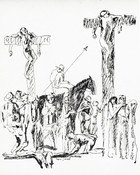
Visions des souffrances (The Crucifixion)
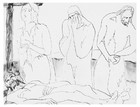
Visions des souffrances (The Death of Jesus)

Visions des souffrances (Death is Conquered)
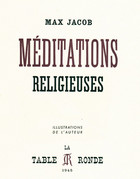
Meditations Religieuses (Title page)
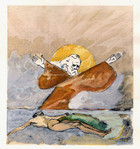
Meditations Religieuses (Creation of Adam)
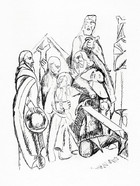
Meditations Religieuses (Adoration of the Magi)
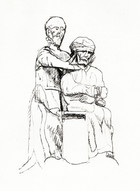
Meditations Religieuses (Christ Mocked)
